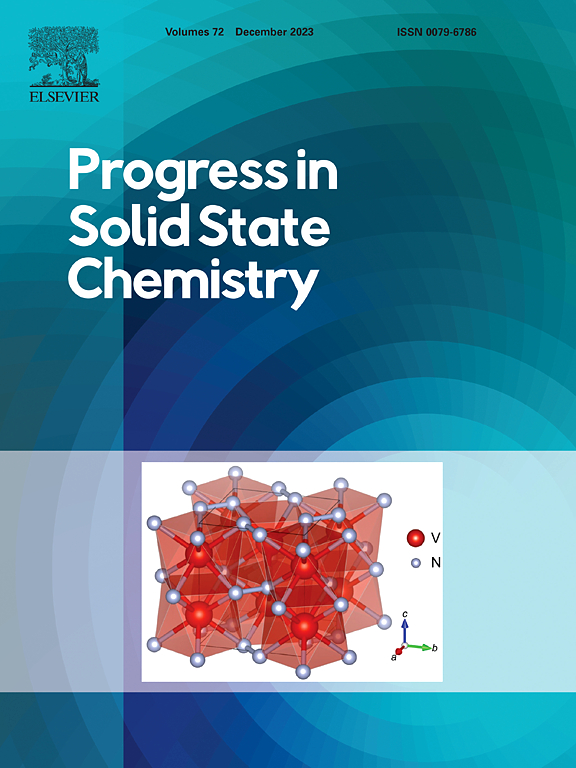无机化合物中温度诱导的结构相变:对称性和信息熵分析
IF 10.5
2区 化学
Q1 CHEMISTRY, INORGANIC & NUCLEAR
引用次数: 0
摘要
晶体结构对称性随温度升高而增加的趋势(也称为“朗道规则”)是关于温度诱导相变的主要经验观察之一。通过对已知晶体结构信息的无机化合物中502个温度驱动相变的统计分析,验证了该规律的有效性。分析是从对称考虑的角度进行的(即,根据晶体系统层次结构进行分析,其中立方系统最高,三斜系统最低)和信息熵计算。结果表明,基于信息的结构复杂性参数(最重要的是每个简化的单位胞的总信息量)是比对称分类更敏感的结构对称性指标。在考虑的相变中,超过77%的信息熵测量值随着温度的升高而降低,这对应于加热下对称性的整体上升(“朗道规则”)。相比之下,简单的对称分析只在60%的情况下证实了“朗道规则”。在晶体系统不发生变化的情况下(大多数是单斜-单斜和正交-正交转变),基于信息的参数特别有效。与增加对称性规则的偏离对应于:具有高复杂性的中间(过渡)结构的相变序列,等对称和可重入的相变,以及涉及低温亚稳态多晶的相变。有一些例外不能被分配到上述任何相变类型,其中对称性在加热下下降。对称性破缺导致振动熵的减少,这可能被认为是“朗道规则”背后的主要驱动力。然而,各种现象,如键的形成和断裂、电荷和轨道的排序、孤电子对的立体活性等,都可能严重影响温度变化下的多晶转变。本文章由计算机程序翻译,如有差异,请以英文原文为准。
Temperature-induced structural phase transitions in inorganic compounds: symmetry and information-entropy analysis
The tendency of crystal-structure symmetry increasing under increasing temperature (also known as a ‘Landau rule’) is one of the major empirical observations with regard to the temperature-induced phase transitions. The validity of the rule was investigated by means of the statistical analysis of the 502 temperature-driven phase transitions in inorganic compounds with known crystal-structure information for all polymorphs. The analysis was performed from the viewpoint of symmetry considerations (that is, the analysis in terms of the crystal-system hierarchy, where cubic system is the highest and triclinic is the lowest) and information-entropy calculations. It was revealed that the information-based structural complexity parameters (most importantly, the total information content per reduced unit cell) are more sensitive structural symmetry indicators than the symmetry classification in terms of the crystal-system hierarchy. The information-entropy measures decrease under increasing temperature in more than 77 % of phase transitions under consideration, which corresponds to the overall rise of symmetry under heating (the ‘Landau rule’). In contrast, the simple symmetry analysis confirms the ‘Landau rule’ in 60 % of cases only. The information-based parameters are especially efficient for the cases, when crystal system does not change (most numerous are monoclinic-monoclinic and orthorhombic-orthorhombic transitions). The deviations from the rule of increasing symmetry correspond to: phase transition sequences with intermediate (transitional) structures of high complexity, isosymmetric and reentrant phase transitions, and transitions that involve low-temperature metastable polymorphs. There are some exceptions that cannot be assigned to any of the phase-transition types mentioned above, where symmetry is decreasing under heating. The symmetry breaking results in the decrease in vibrational entropy, which may be considered as a major driving force behind the ‘Landau rule’. However, various phenomena such as formation and breaking of bonds, charge and orbital ordering, stereoactive activity of lone electron pairs, etc., may seriously influence polymorphic transformations under temperature changes.
求助全文
通过发布文献求助,成功后即可免费获取论文全文。
去求助
来源期刊

Progress in Solid State Chemistry
化学-无机化学与核化学
CiteScore
14.10
自引率
3.30%
发文量
12
期刊介绍:
Progress in Solid State Chemistry offers critical reviews and specialized articles written by leading experts in the field, providing a comprehensive view of solid-state chemistry. It addresses the challenge of dispersed literature by offering up-to-date assessments of research progress and recent developments. Emphasis is placed on the relationship between physical properties and structural chemistry, particularly imperfections like vacancies and dislocations. The reviews published in Progress in Solid State Chemistry emphasize critical evaluation of the field, along with indications of current problems and future directions. Papers are not intended to be bibliographic in nature but rather to inform a broad range of readers in an inherently multidisciplinary field by providing expert treatises oriented both towards specialists in different areas of the solid state and towards nonspecialists. The authorship is international, and the subject matter will be of interest to chemists, materials scientists, physicists, metallurgists, crystallographers, ceramists, and engineers interested in the solid state.
 求助内容:
求助内容: 应助结果提醒方式:
应助结果提醒方式:


